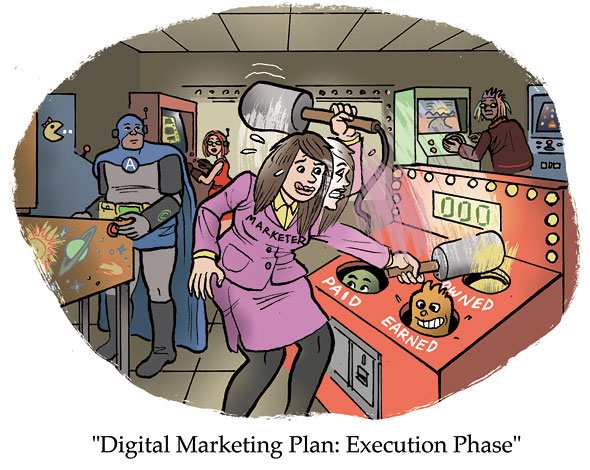How to Create a Digital Marketing Strategy

Coming up with an effective digital marketing strategy for your business can feel like a moving target, especially with how fast trends and technologies evolve. To make your strategy truly effective, it has to account for both what’s changing in digital marketing today and how your business might grow tomorrow.
Your digital marketing strategy serves as a roadmap for your brand online. It helps you make smarter, data-backed decisions rather than relying on instinct or reacting to trends on the fly. With a clear plan in place, your team can focus resources efficiently and adapt quickly when, not if, the digital landscape shifts.
In short, digital marketing decisions shouldn’t be made on impulse. A strategy keeps you grounded, focused, and ready for whatever comes next.
Creating Priorities, Not Business Plans
When knowing how to create a digital marketing strategy, we often fall into the misconception that you should treat it like your business plan. While both are goal-oriented, they serve different purposes. Your business plan defines your company’s direction; your digital strategy defines how you’ll communicate, market, and grow in a constantly shifting digital space.
What realities should you consider when writing your digital strategy?
A strong digital marketing strategy isn’t about predicting the future; it’s about creating a system that can thrive in uncertainty, one that aligns your people, processes, and priorities so your brand doesn’t just react to change but uses it to grow.
3 Essential Parts of Your Digital Marketing Strategy
A well-rounded digital marketing strategy ties together every moving part of your online presence, from people and processes to platforms and priorities. Think of it as your blueprint for execution: it defines who does what, how decisions are made, and what success looks like.
Your strategy should cover these three key components: People, Policies, and Priorities.
People
Start by identifying who’s in charge of the different areas of your digital marketing ecosystem.
Clearly outline who makes decisions, who executes, and who ensures quality. This structure prevents confusion and ensures accountability at every level.
For instance, you may have an in-house content team managing blogs and email campaigns, while outsourcing SEO or paid ads to a digital marketing consultant or agency partner. Defining responsibilities early helps you streamline collaboration and maximize resources.
Be specific. Document roles, limitations, and escalation processes. That clarity allows your digital marketing strategy to function even when teams change or expand. Most importantly, be clear about who’s responsible (the do-er) and who’s accountable (the leader).
Policies
Your policies act as your brand’s guardrails, the rules that keep messaging, visuals, and engagement consistent across platforms.
These might include:
Treat these policies as living documents. Update them regularly as new channels, tools, and digital marketing services evolve. Every time your brand adds a new platform or tactic, your policies should adapt to keep everything cohesive.
Priorities
Your digital marketing priorities stem from your business objectives, but they’re not identical. Business goals focus on growth; digital goals define how you’ll achieve it online.
List your main objective (e.g., lead generation, customer retention, brand visibility), then identify which audiences and channels align best with each one. Each campaign should only have 1 clear goal. If you have multiple goals, there should be a project or campaign for each goal.
From there:
That roadmap becomes invaluable as your team, or future teams, maintain campaigns over time. It ensures continuity, minimizes confusion, and keeps everyone focused on measurable outcomes rather than one-off tactics.
Creating a Development Strategy
Even though you can’t plan every campaign years ahead, you still need a short- to mid-term roadmap to guide your digital efforts. This roadmap acts as your tactical plan, outlining which projects to prioritize, which teams are accountable, and how to measure success.
Focus first on what needs to happen immediately, the high-impact, near-term items that move your digital marketing strategy forward. Then, note longer-term initiatives that can evolve as your business and technology landscape change. This balance gives you flexibility while keeping you aligned with your goals.
Every roadmap will look different depending on your business model and resources, but the most effective digital marketing strategies share a common structure. They include details that go beyond your website and touch every major touchpoint of your customer experience.
Website
Your website is the anchor of your online presence. It’s where your brand, content, and conversions come together.
Define the design, functionality, and content goals early, including who maintains each area. Assign ownership for updates across design, content, and technical performance.
A good digital marketing strategy example might include:
Mobile
With mobile usage dominating online activity, having a responsive and accessible mobile experience is non-negotiable. At minimum, ensure your website is mobile-optimized. If your business model supports it, explore creating a native app for an even more direct engagement channel.
Document which platforms you’ll support (iOS, Android, or both), and plan for periodic updates as operating systems evolve.
Digital Marketing
This part covers the heart of your execution, the mix of digital marketing services that drive awareness, engagement, and leads.
Your plan should include a clear approach to:
Keep this section flexible. Search algorithms, ad policies, and audience behaviors shift constantly, so your strategy should make room for quick pivots when updates hit.
Social Media
Decide which platforms best match your target audience and what purpose each will serve. Outline how you’ll use social media for content promotion, brand storytelling, and customer interaction.
Set clear policies on tone, response time, and crisis management, especially important when handling negative feedback or trending issues.
Email Marketing
Who said email marketing is dead?
Email remains one of the most reliable channels for retention and conversion. Document the types of emails you’ll send (newsletters, promos, automated follow-ups), who manages them, and your process for securing subscriber data. Clarity here keeps your communication consistent and your brand trustworthy.
A well-built development strategy connects every moving piece of your marketing ecosystem. It gives your business structure today, and adaptability tomorrow.
Let’s Talk Money
No strategy is complete without addressing the numbers.
A solid digital marketing strategy isn’t just about creative ideas, it’s about knowing how much you can invest and how to allocate it smartly across channels.
Budgeting in digital marketing is tricky because the landscape changes constantly. Campaign performance, platform updates, and emerging tools can all shift your priorities. Instead of locking in a rigid forecast, create a flexible budgeting framework that lets you reallocate funds based on what’s working.
Here’s how you can approach it:
Remember, digital marketing isn’t a one-time project. It’s an ongoing process that evolves with your audience and your goals. The most effective strategies are agile, allowing you to test, measure, and adapt continuously.
If your current setup feels too vague or hard to manage, that’s where expert guidance helps. Working with a digital marketing consultant like Truelogic gives you access to data-backed insights, hands-on support, and scalable solutions that fit your growth stage.
Creating your digital marketing strategy takes work, but it’s the kind of work that pays off.
Start by clarifying your priorities, building a roadmap, and aligning your resources. When you’re ready, our team at Truelogic can help you bring it all together.
Create Your Digital Marketing Strategy Today
Don’t wait for trends to dictate your next move.
Build a strategy that evolves with your business, one that helps you stay visible, relevant, and ready for what’s next.
Talk to our digital marketing consultants today and find out how we can help your brand grow smarter.










